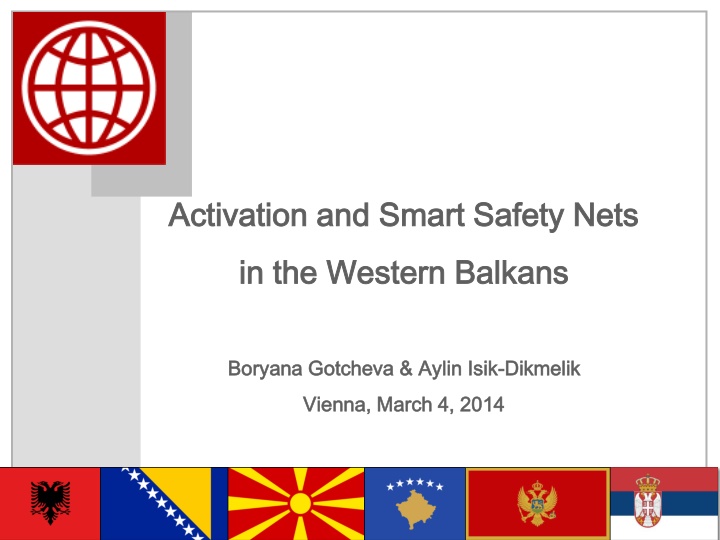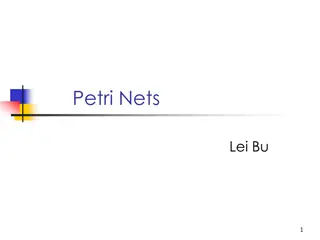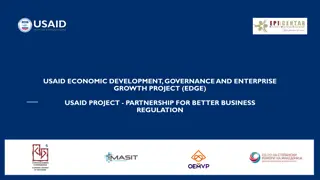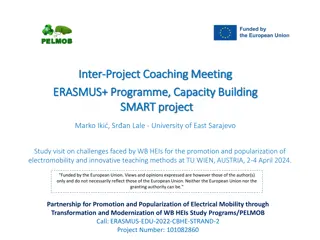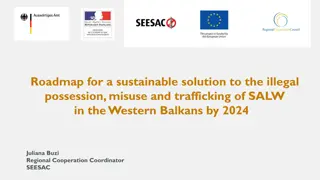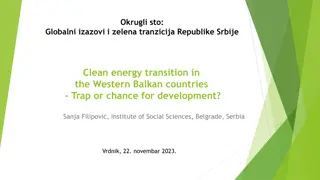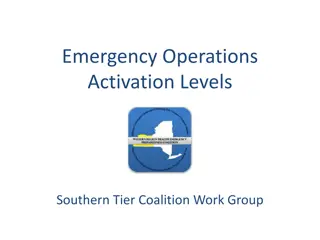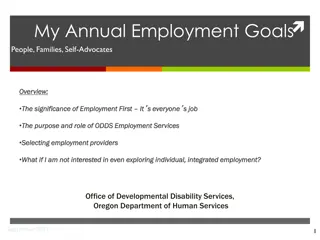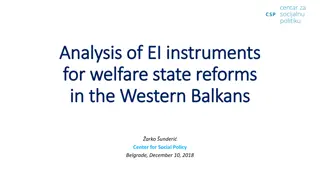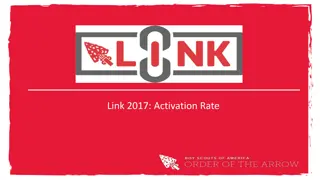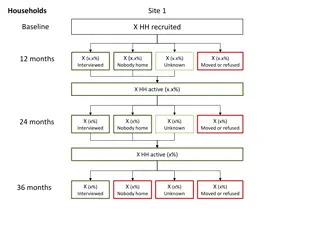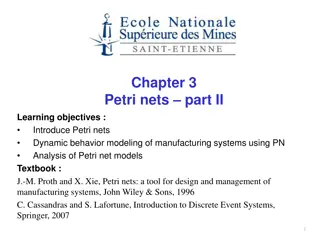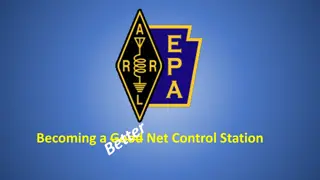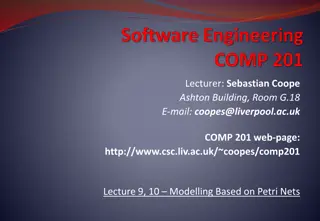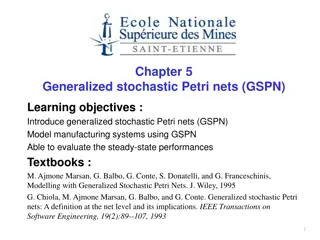Activation and Smart Safety Nets in the Western Balkans: Addressing Employment Challenges
Activation strategies aim to transition individuals from dependence on social benefits to active participation in the labor market. The Western Balkans face high unemployment rates, highlighting the need for effective activation policies. By emphasizing employability and reintegration, activation initiatives help individuals overcome barriers to entering or re-entering the job market.
Download Presentation

Please find below an Image/Link to download the presentation.
The content on the website is provided AS IS for your information and personal use only. It may not be sold, licensed, or shared on other websites without obtaining consent from the author.If you encounter any issues during the download, it is possible that the publisher has removed the file from their server.
You are allowed to download the files provided on this website for personal or commercial use, subject to the condition that they are used lawfully. All files are the property of their respective owners.
The content on the website is provided AS IS for your information and personal use only. It may not be sold, licensed, or shared on other websites without obtaining consent from the author.
E N D
Presentation Transcript
Activation and Smart Safety Nets Activation and Smart Safety Nets in the Western Balkans in the Western Balkans Boryana Boryana Gotcheva Gotcheva & Aylin Vienna, March 4, 2014 Vienna, March 4, 2014 & Aylin Isik Isik- -Dikmelik Dikmelik
Outline Outline Why activation? What is the challenge? What is activation? The Western Balkans Activation and Smart Safety Nets Study: Content Outputs Analytical framework Going forward
The Challenge The Challenge Employment Employment and active inclusion critical challenges for countries across the Western Balkans active inclusion are among the most
Daunting jobs challenge with low activity and Daunting jobs challenge with low activity and employment rates employment rates 80 Employment (age 15+), Q4, 2011 70 60 50 Percentage 40 30 20 10 0 Netherlands Denmark Croatia UK Spain Serbia* Austria Hungary Bulgaria Moldova Poland Azerbaijan* Luxembourg Albania* Latvia Belgium Montenegro Germany Czech Republic Estonia Ireland Lithuania Romania FYR Macedonia France Italy Portugal Slovakia Turkey Greece Kosovo Georgia* B&H Kazakhstan Slovenia Belarus* Armenia*
and unemployment rates that are among the and unemployment rates that are among the highest in Europe highest in Europe 25 20 Unemployment rate (latest available) 15 10 5 0 Unemployment rates, 2008-2012 CIS Western Balkans Non-ECA Europe Baltics ECA
What is activation? Activation has a history across the world Shift from passive to active social policies Primary focus on employability and labor market re-attachment The European model of activation policies generally place employment integration at the very heart of social policy This implies: Greater emphasis on work as a way to ensure that individuals in their prime age are not excluded from mainstream society Greater effort by the social and employment services in helping inactive, unemployed and benefit recipients overcome the obstacles to entering into paid work Greater effort by the inactive, unemployed, and recipients to enter or re-enter the job market
Key building blocks of activation Key building blocks of activation 1. The mutual obligations principle 2. Frequent and personalized/tailored interventions of agencies during individual s unemployment spell 3. Financial incentives to labor market re-integration 4. Stricter benefit eligibility criteria and benefit sanctions 5. Strong obligations to participate in labor market programs, community work or, to try self-employment 6. Changes in institutional arrangements and greater coordination across institutions
Promoting Employability Promoting Employability a and reducing reliance on social transfers social transfers nd reducing reliance on Activation Package of incentives & support services Integrated Integrated Service Models Service Models Tailored to Tailored to Clients Clients Employment & Employment & Social Service Social Service Supports Supports Benefit Incentives Benefit Incentives
Activation is for both the inactive and those who Activation is for both the inactive and those who are active but without a job are active but without a job WITHOUT A JOB but active INACTIVE Out of the LF Non-Poor Poor SSN-Beneficiaries Productivity Increase WITH A JOB
The Western Balkans Activation and Smart The Western Balkans Activation and Smart Safety Nets Safety Nets Study Study Builds on previous research Social Protection Systems in Western Balkans Country-specific case studies for all Western Balkans including entity- level cases in BH Advice to the Governments on policy changes that promote activation Assistance on how to implement activation policies
Framework Framework for the analysis for the analysis Target Groups? (Dis)Incentives in Benefit Design Coordination between welfare and employment services Specific activation policies and ALMPs Implementation capacity (financing, staffing, etc.) Inactive Unemployed SSN Beneficiaries Barriers to Work? Benefit formula Generosity/ package Mutual obligations Duration/ phase out (Dis)incentives in tax and benefit systems Earned income disregards Employability barriers (skills, experience, etc.) Participation constraints Activation for Who? PROFILING Institutional Readiness for Activation Policies
Coverage of countries and activities Coverage of countries and activities (Dis)incentives (Dis)incentives in the design the design in Institutional Institutional capacity capacity Country Country Profiling Profiling Phase 1 Phase 1- -2 (2012 2 (2012- -13) 13) FYR Macedonia FYR Macedonia Kosovo Kosovo Montenegro Montenegro Serbia Serbia Phase 3 (2013 Phase 3 (2013- -14) 14) Albania Albania Bosnia Bosnia and Herzegovina Herzegovina and
Activation for Who? Profiling: SERBIA Activation for Who? Profiling: SERBIA Target Groups? (Dis)Incentives in Benefit Design Inactive Unemployed SSN Beneficiaries Barriers to Work? Employability barriers (skills, experience, etc.) Participation constraints Activation for Who? PROFILING Institutional Readiness for Activation Policies
Analytical framework to analyze constraints to Analytical framework to analyze constraints to employment of safety nets beneficiaries employment of safety nets beneficiaries Employability barriers Tax and Benefit Disincentives Participation constraints These barriers are interrelated
Objective of Objective of Profiling of Social Safety Net Profiling of Social Safety Net beneficiaries beneficiaries Providing tailored activation strategies for a diverse vulnerable population Who can be activated in the population? Who are the activable among SSN beneficiaries? Profile of the activable What are the employability barriers? Are there additional constraints to their participation ? What are the main client segments for activation? What graduation strategies suit each group?
Who can be activated? Who can be activated ? Of working age (15-64) Able bodied Activables: Not in education or training Individuals who can be presumed to be able to work Who can be activated among the population? Who can be activated among the population? Who can be activated among the SSN beneficiaries? Who can be activated among the SSN beneficiaries? Are these groups coinciding? Are these groups coinciding?
More than half of population in Serbia are work More than half of population in Serbia are work- -able (potentially (potentially activable activable ) ) able Age Composition of SSN Beneficiaries Relative to General Population in Serbia, 2010 FSA beneficiary 26.4 11.0 4.7 54.8 FSA+CA beneficiaries 11.3 32.1 6.1 50.0 SSN all 27.1 9.6 8.6 52.9 Whole population 12.6 22.1 8.0 56.8 0 20 40 60 80 100 Percent Child Old Working age (disabled) Working age (in education) Working age (work-able) Source: Serbia HBS data 2010. Note: Work-able includes all individuals of working age (15 64) who are neither disabled nor in education or training.
SSN SSN beneficiaries represent beneficiaries represent only a small the work the work- -able able population population only a small fraction of fraction of Focusing Focusing only only on SSN beneficiaries on SSN beneficiaries will will have limited impact in the LM have limited impact in the LM Safety Net Coverage of the Work-Able Population in Serbia, 2010 Out 72.8 13.5 9 5. of labor force Unemployed 83.3 8.5 6 1.9 Employed 79.0 13.0 6 0 20 40 60 80 100 Percent Nonbeneficiaries in Q2-Q5 Nonbeneficiaries in Q1 Beneficiaries of other SSN FSA beneficiaries Source: Serbia HBS data 2010. Note: Work-able includes all individuals of working age (15 64) who are neither disabled nor in education or training.
SSN Beneficiaries more likely to be unemployed or SSN Beneficiaries more likely to be unemployed or inactive or have low inactive or have low- -quality jobs quality jobs Employment and Unemployment rates among the work-able population in Serbia, 2010 Sector of Employment for work-able Population in Serbia, 2010 FSA 56.5 20.7 22.8 beneficiaries FSA 56.1 beneficiaries FSA + CA beneficiaries 58.1 21.9 20.1 SSN beneficiaries 13 30.3 12.7 44.1 SSN beneficiaries 56.8 20.7 22.4 Nonbeneficiaries , poor 17.2 27.8 14.7 40.3 Non- 55.2 25.9 18.8 beneficiaries, poor Whole population 34.4 28.6 11.2 25.7 Whole population 63.0 16.4 20.6 0 20 40 60 80 100 Percent 0 20 40 60 80 100 Public and professions Retail, trade, crafts Percent Constr., industry, transport Agriculture and manual jobs Employed Unemployed Out of labor force Not identified* Source: Serbia HBS data 2010. Note: Work-able includes all individuals of working age (15 64) who are neither disabled nor in education or training * Because of the sample size, conclusions cannot be drawn about the sectors other than Agriculture and manual jobs. .
Which could be largely explained by lower educational Which could be largely explained by lower educational attainment attainment Education Distribution of SSN Beneficiaries in Serbia, 2010 FSA beneficiaries 17.3 33.5 40.8 SA + CA beneficiaries 12.1 28.5 52.5 Nonbeneficiaries, poor 9.0 29.2 56.4 SSN beneficiaries 11.0 28.0 53.0 Activable population 5.4 19.0 59.3 0 10 20 30 40 50 60 70 80 90 100 Percent Never attended No education completed Elementary school Secondary/Vocational Higher education (college or higher) Source: Serbia HBS data 2010. Note: Work-able includes all individuals of working age (15 64) who are neither disabled nor in education or training.
Work Work- -able SSN beneficiaries display greater caretaking able SSN beneficiaries display greater caretaking needs than needs than the work the work- -ready population as a ready population as a whole whole Share of work-able population living with at least one person in need of care in Serbia, 2010 15.4 FSA beneficiaries 29.8 23.7 2.4 FSA+CA beneficiaries 8.2 4.9 9.5 SSN all 31.5 20.4 2.6 General population 9.4 5.3 0 5 10 15 20 25 30 35 Percent % hh with disabled % hh with child 5 % hh with child 2 Source: Serbia HBS data 2010. Note: Work-able includes all individuals of working age (15 64) who are neither disabled nor in education or training.
Latent Class Analysis: SERBIA Latent Class Analysis: SERBIA Inactive uneducated women, 21% Elder experienced unemployed, 35% Elder experienced inactive, 16% Inexperienced unemployed women,, 12% Educated unemployed youth, 8% Chronic unemployed, 8%
These groups display different employability & labor supply constraints (high) Employability Obstacles (Skills, Experience) 23 Other Barriers to Participation (Social, Circumstances, Other) (high)
Which call for different packages of services Size= % of total work-able FSA beneficiaries Intensified Activation (TVET, Skills) Hard-to-serve 4 (skills, special support) 3.5 Chronic unemployed Inactive uneducated women Employability obstacles 3 Elder Inexperienced unemployed women experienced unemployed 2.5 2 Experienced inactive elder 1.5 Educated unemployed youth Special Support (care for dependents, transport, social, health) 1 Market Ready (job info, matching, search assistance) 0.5 0 0 0.5 1 1.5 2 2.5 3 3.5 Other barriers to participation
(Dis)Incentives in Benefit Design (Dis)Incentives in Benefit Design (Dis)Incentives in Benefit Design Benefit formula Generosity/ package Mutual obligations Duration/ phase out (Dis)incentives in tax and benefit systems Earned income disregards Activation for Who? PROFILING Institutional Readiness for Activation Policies
FYR Macedonia Social FYR Macedonia Social Financial Assistance Financial Assistance Design, financing and Design, financing and implementation implementation Type of program Type of program Basic administrative data Basic administrative data Minimum income guarantee / last resort social assistance Granted to individuals (and their households) that are able to work but cannot provide for themselves materially Works as a substitute for the contributory unemployment benefit which is received by only 9 percent of the unemployed Centrally designed Centrally designed: by the Ministry of Labor and Social Policy Centrally financed Implementation at local level: by inter-municipal Social Work Centers which are de-concentrated structures of MLSP Number of beneficiaries: 35,450 (2012) beneficiary families , encompassing 115,000 direct and indirect beneficiaries Spending: about 1.1 billion (about 23 million USD) (2012) Spending is around 0.3 percent of GDP (2011), which is at the regional average, but declining since 2007
SFA SFA design implies both incentives and design implies both incentives and disincentives to work disincentives to work Incentives Disincentives
Work incentives Work incentives exist mainly as work exist mainly as work requirements requirements Job search, participation in ALMPs and training, job Job search, participation in ALMPs and training, job interviews; job offers; municipal PWP and seasonal jobs interviews; job offers; municipal PWP and seasonal jobs Monitoring of compliance is relatively strict Monitoring of compliance is relatively strict There are sanctions for non There are sanctions for non- -compliance with work requirements, but the right to FSA can be transferred requirements, but the right to FSA can be transferred compliance with work
Additional incentives exist Additional incentives exist SFA benefit declines with time to 50 percent of the initial amount after three consecutive years of receipt SFA beneficiaries can be engaged in public works up to five days per month without losing the right of SFA PWP income not disregarded, but reentry to the SFA program easier Legal Guarantee for Legal Guarantee for SFA status while on SFA status while on PWP PWP Declining Schedule Declining Schedule for Receipt of SFA for Receipt of SFA
Disincentives for work Disincentives for work stem from the SFA benefit stem from the SFA benefit formula formula The benefit is calculated as difference between the SFA threshold difference between the SFA threshold applicable to a family of that size and its monthly income applicable to a family of that size and its monthly income Each additional denar earned is taken away from the benefit amount due -> 100 percent marginal effective tax rate Generosity is less of an issue: core Generosity is less of an issue: core SFA benefit is not very Generosity is measured as percentage of the consumption in the poorest quintile covered/paid for with the benefit amount but there s packaging with other benefits such as electricity subsidy Health insurance is de-linked from SFA status (no longer part of the package). Poor, including SFA beneficiaries, are eligible for free health care, but it is provided outside the social assistance system SFA benefit is not very generous generous
Disincentives could emerge from the design of Disincentives could emerge from the design of activation measures activation measures Participation in activation could undermine eligibility for SFA Participation in activation could undermine eligibility for SFA No legal guarantees for restoring SFA status after finishing participation in activation, exception are PWPs Standard re-certification rules apply, no flexibility of in and out Incomes from training, other ALMPs, and from public works are fully calculated in the family income Will impact the outcomes from activation
Overall, modern social assistance programs for work Overall, modern social assistance programs for work able poor have more incentives for activation able poor have more incentives for activation Guaranteed minimum income / last resort programs to be open for Guaranteed minimum income / last resort programs to be open for poor of working age and able to work when they are short of income poor of working age and able to work when they are short of income Some incomes from work could be disregarded Income thresholds for program exit could be higher than the entry thresholds Some benefits could phase out gradually / be carried over for some time after the beneficiary gets a job (in-work) Would help avoid the disincentive effect of high taxation of low incomes from work
Institutional Readiness for Activation Institutional Readiness for Activation Policies Policies (Dis)Incentives in Benefit Design Coordination between welfare and employment services Specific activation policies and ALMPs Implementation capacity (financing, staffing, etc.) Activation for Who? PROFILING Institutional Readiness for Activation Policies
Two main service delivery mechanisms in the region Two main service delivery mechanisms in the region which are not coordinated which are not coordinated Limited Limited interaction interaction between employment services and between employment services and centers centers for for social work social work Cooperation varies Cooperation varies across localities across localities better where local offices in the same or close premises Lack of formal referral procedure Lack of formal referral procedure for beneficiaries to employment beneficiaries to employment services for social assistance social assistance services High High and uneven caseloads and uneven caseloads in many work and employment offices work and employment offices - - little room for casework in many centers for social centers for social
Labor market institutions in place, but capacity for Labor market institutions in place, but capacity for activation on a large scale still activation on a large scale still insufficient insufficient Limited capacity for individualized interventions Limited capacity for individualized interventions Due to the high client to staff ratio Financing constraints Financing constraints for active Low level of spending on active policies ranging only 0.1-0.2% GDP significantly lower than the EU-27 average for active m measures easures Lack of outsourcing Lack of outsourcing of the counseling services to non counseling services to non- -state The regulatory framework for outsourcing is not fully developed of the job placement job placement and/or state providers providers and/or
Going forward: Going forward: a activation agenda much broader than ctivation agenda much broader than just focusing just focusing on addressing welfare dependency on addressing welfare dependency Activation agenda goes beyond safety net beneficiaries Activation agenda goes beyond safety net beneficiaries: They are only a fraction of the inactive, and activation measures that only target them will not bring significant impact Smarter design of last resort social assistance programs Smarter design of last resort social assistance programs needed needed Enable/promote access to working poor while building in incentives for work (e.g. introduction of gradual income disregard, in-work benefits etc.)
Next steps in the broader activation agenda Next steps in the broader activation agenda Substantial amount of diagnostic work legislative changes for future reforms diagnostic work in place to inform Room for country for additional knowledge, information and provide just-in- time technical assistance country- -specific follow up work specific follow up work to address needs Investments to reform and strengthen the institutional Investments to reform and strengthen the institutional set up up for the provision of differentiated and at the same time integrated services that would help reduce multiple barriers to work and activate broader groups of inactive set
Next steps in the broader activation agenda Next steps in the broader activation agenda Possible institutional reforms for promotion of activation Improving the capacity for planning and designing activation measures, and evaluation of their effectiveness Improving the capacity and effectiveness of the public employment services for implementing activation measures Strengthening inter-institutional cooperation especially between the employment services and the centers for social work for a holistic approach to effective activation of vulnerable Improving the cost-effectiveness of the ALMPs and other interventions e.g. increased competition, advanced (statistical) profiling, application of job matching software tools, etc.
THANK YOU! THANK YOU! Boryana Gotcheva bgotcheva@worldbank.org Aylin Isik-Dikmelik aisikdikmelik@worldbank.org
Latent Class Analysis: SERBIA Latent Class Analysis: SERBIA Elder experienced unemployed Inactive uneducated women Elder experienced inactive Inexperienced unemployed women Educated unemployed youth Chronic unemployed Class size 35% 21% 16% 12% 8% 8% Worked before 100% 19% 95% 24% 20% 21% Indicators Willing to retrain 54% 23% 5% 45% 66% 73% Inactive 22% 100% 100% 16% 0% 19% Long-term unemployed 66% 0% 0% 63% 99% 6% Short-term unemployed Uneducated Elementary education 12% 6% 34% 0% 31% 54% 0% 21% 36% 21% 31% 38% 0% 20% 37% 75% 6% 21% Active covariates Secondary+ education 61% 16% 43% 31% 43% 73% Young (15 29) 4% 41% 8% 26% 39% 92% Adult (30 54) Prime age (55 64) Female 54% 42% 41% 52% 7% 82% 45% 47% 34% 59% 15% 92% 61% 0% 28% 4% 4% 26% Caretaker Married Discouraged inactive (% of total) 0% 62% 20% 33% 65% 56% 32% 64% 78% 0% 48% 8% 0% 55% 0% 0% 9% 14% Statistics Willing inactive (% of total) Mean age 2% 44% 22% 8% 0% 5% 46 32 47 36 31 23
